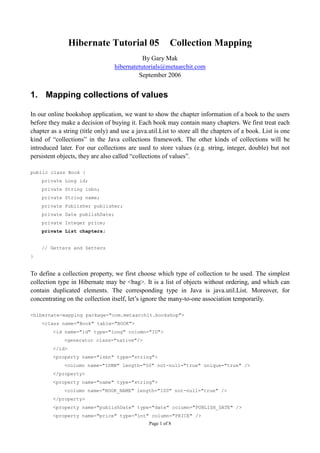This document discusses mapping collections in Hibernate, including different collection types like bags, lists, sets, maps and arrays. It explains how to define a collection property in Hibernate mapping files and customize aspects like lazy loading, fetching strategies and sorting. Common collection types like bags and lists are demonstrated with examples.





![public class Book {
...
private String[] chapters;
}
<hibernate-mapping package="com.metaarchit.bookshop">
<class name="Book" table="BOOK">
...
<array name="chapters" table="BOOK_CHAPTER">
<key column="BOOK_ID" />
<list-index column="CHAPTER_INDEX"/>
<element column="CHAPTER" type="string" length="100" />
</array>
</class>
</hibernate-mapping>
2.5. Map
A <map> is very similar to a <list>. The difference is that a map uses arbitrary keys to index the
collection, not an integer index using in a list. A map stores its entries in key/value pairs. You can
lookup the value by its key. The key of a map can be of any data types. The corresponding type of a
<map> in Java is java.util.Map.
The table structure of the following <map> contains three columns, BOOK_ID, CHAPTER and
CHAPTER_KEY. Here we choose string as the data type of our key column.
public class Book {
...
private Map chapters;
}
<hibernate-mapping package="com.metaarchit.bookshop">
<class name="Book" table="BOOK">
...
<map name="chapters" table="BOOK_CHAPTER">
<key column="BOOK_ID" />
<map-key column="CHAPTER_KEY" type="string" />
<element column="CHAPTER" type="string" length="100" />
</map>
</class>
</hibernate-mapping>
Page 6 of 8](https://image.slidesharecdn.com/hibernatetutorial05collections-120308235645-phpapp01/85/Hibernate-collections-6-320.jpg)

